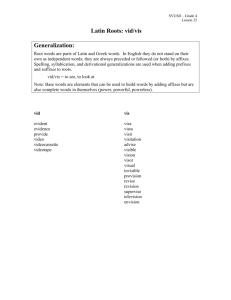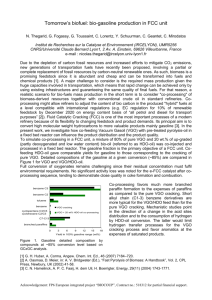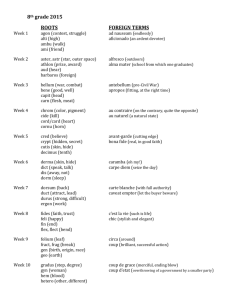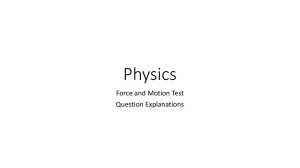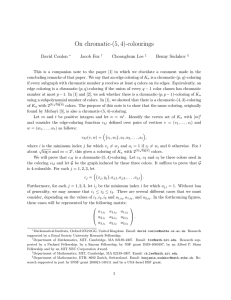LIE ALGEBRAS Construction of a Lie algebra attached to a root system.
advertisement
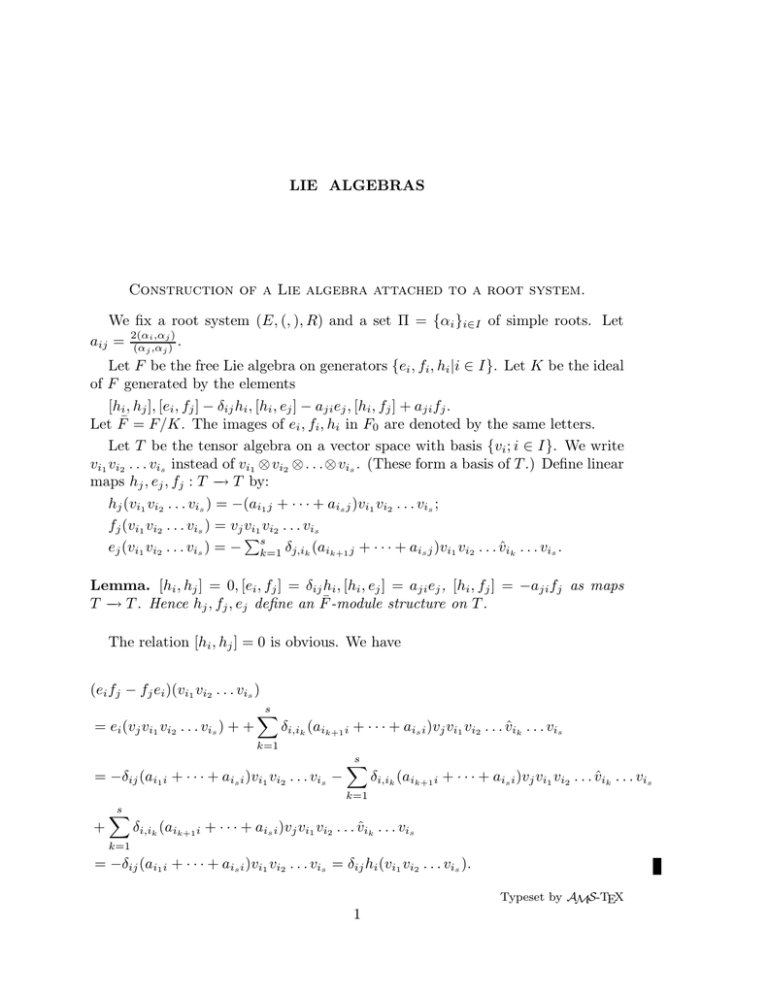
LIE ALGEBRAS
Construction of a Lie algebra attached to a root system.
We fix a root system (E, (, ), R) and a set Π = {αi }i∈I of simple roots. Let
2(α ,α )
aij = (αji,αjj) .
Let F be the free Lie algebra on generators {ei , fi , hi |i ∈ I}. Let K be the ideal
of F generated by the elements
[hi , hj ], [ei , fj ] − δij hi , [hi , ej ] − aji ej , [hi , fj ] + aji fj .
Let F̄ = F/K. The images of ei , fi , hi in F0 are denoted by the same letters.
Let T be the tensor algebra on a vector space with basis {vi ; i ∈ I}. We write
vi1 vi2 . . . vis instead of vi1 ⊗ vi2 ⊗ . . . ⊗ vis . (These form a basis of T .) Define linear
maps hj , ej , fj : T −
→ T by:
hj (vi1 vi2 . . . vis ) = −(ai1 j + · · · + ais j )vi1 vi2 . . . vis ;
fj (vi1 vi2 . . . vis ) = vj vi1 vi2 . . . vis
Ps
ej (vi1 vi2 . . . vis ) = − k=1 δj,ik (aik+1 j + · · · + ais j )vi1 vi2 . . . v̂ik . . . vis .
Lemma. [hi , hj ] = 0, [ei , fj ] = δij hi , [hi , ej ] = aji ej , [hi , fj ] = −aji fj as maps
T −
→ T . Hence hj , fj , ej define an F̄ -module structure on T .
The relation [hi , hj ] = 0 is obvious. We have
(ei fj − fj ei )(vi1 vi2 . . . vis )
= ei (vj vi1 vi2 . . . vis ) + +
s
X
δi,ik (aik+1 i + · · · + ais i )vj vi1 vi2 . . . v̂ik . . . vis
k=1
= −δij (ai1 i + · · · + ais i )vi1 vi2 . . . vis −
s
X
δi,ik (aik+1 i + · · · + ais i )vj vi1 vi2 . . . v̂ik . . . vis
k=1
+
s
X
δi,ik (aik+1 i + · · · + ais i )vj vi1 vi2 . . . v̂ik . . . vis
k=1
= −δij (ai1 i + · · · + ais i )vi1 vi2 . . . vis = δij hi (vi1 vi2 . . . vis ).
Typeset by AMS-TEX
1
2
LIE ALGEBRAS
Thus, [ei , fj ] = δij hi holds. We have
(hi ej − ej hi )(vi1 vi2 . . . vis )
=−
s
X
δj,ik (aik+1 j + · · · + ais j )hi (vi1 vi2 . . . v̂ik . . . vis )
k=1
− (ai1 i + · · · + ais i )
s
X
δj,ik (aik+1 j + · · · + ais j )vi1 vi2 . . . v̂ik . . . vis
k=1
=
s
X
δj,ik (aik+1 j + · · · + ais j )(ai1 i + · · · + âik i + · · · + ais i )(vi1 vi2 . . . v̂ik . . . vis )
k=1
− (ai1 i + · · · + ais i )
s
X
δj,ik (aik+1 j + · · · + ais j )vi1 vi2 . . . v̂ik . . . vis
k=1
=
s
X
δj,ik (aik+1 j + · · · + ais j ) − aik i (vi1 vi2 . . . v̂ik . . . vis )
k=1
= −aji
s
X
δj,ik (aik+1 j + · · · + ais j )(vi1 vi2 . . . v̂ik . . . vis ) = aji ej (vi1 vi2 . . . vis ).
k=1
Thus, [hi , ej ] = aji ej holds. We have
(hi fj − fj hi )(vi1 vi2 . . . vis )
= hi (vj vi1 vi2 . . . vis ) + (ai1 i + · · · + ais i )fj (vi1 vi2 . . . vis )
= −(aji + ai1 i + · · · + ais i )vj vi1 vi2 . . . vis + (ai1 i + · · · + ais i )vj vi1 vi2 . . . vis
= −aji vj vi1 vi2 . . . vis = −aji fj (vi1 vi2 . . . vis ).
Thus, [hi , fj ] = −aji fj holds. The lemma is proved.
Lemma. Let F̄ + be the Lie subalgebra of F̄ generated by {ei |i ∈ I}. Let F̄ −
be the Lie subalgebra of F̄ generated by {fi |i ∈ I}. Let F̄ 0 be the subspace of F̄
spanned by {hi |i ∈ I}. Then F̄ = F̄ − ⊕ F̄ 0 ⊕ F̄ + and {hi |i ∈ I} is a basis of F̄ 0 .
By the previous lemma there is a unique Lie algebra homomorphism φ : F̄ −
→
End(T ) which sends ei , fi , hi to the endomorphisms described above.
(a) The elements
P {hi |i ∈ I} are linearly independent in F̄ . P
Assume
P that i ci hi = 0 in F̄ . Applying this to vj gives i ci aji vj = 0 in T
hence i ci aij = 0. As (aij ) is nonsingular, we have cj = 0.
(b) Let e(s) be an iterated bracket of s elements ei1 , . . . , eis . Then [hj , e(s)] =
(ai1 j + · · · + ais j )e(s) in F̄ .
We argue by induction on s. For s = 1 this follows from the definition. Assume that s ≥ 1. It is enough to show: if [hj , x] = ax and [hj , x′ ] = a′ x′ then
[hj , [x, x′ ]] = (a + a′ )[x, x′ ] (use Jacobi).
LIE ALGEBRAS
3
(c) Let f (s) be an iterated bracket of s elements fi1 , . . . , fis . Then [hj , f (s)] =
−(ai1 j + · · · + ais j )f (s) in F̄ .
As in (b).
(d) If s′ > s > 0 then [f (s), e(s′ )] is a linear combination of e(s′ − s).
Assume first that s = 1. We argue by induction on s′ . For s′ = 2 we have
[fj , [ei , ei′ ]] = [[fj , ei ], ei′ ] + [ei , [fj , ei′ ]] = [−δij hi , ei′ ] − [ei , δi′ ,j hj ] ∈ kei′ + kei .
Hence the result holds in this case. Assume now that s′ > 2. Then e(s′ ) =
[e(s′′ ), e(s̃′′ )] where s′′ +s̃′′ = s′ , s′′ < s′ , s̃′′ = s′ . If s′′ > 1, s̃′′ > 1 the result follows
from the induction hypothesis using Jacobi. If s′′ = 1 we have e(s′ ) = [ek , e(s′ −1)]
hence
[fj , [ek , e(s′ − 1)]] = [[fj , ek ], e(s′ − 1)] + [ek , [fj , e(s′ − 1)]] = const[hk , e(s′ −
1)] + [ek , lin.combe(s′ − 2)] = lin.combe(s′ − 1).
We now assume that s′ is fixed and use induction on s.
(e) If s > s′ > 0 then [f (s), e(s′ )] is a linear combination of f (s − s′ ).
Same proof as (d).
P
(f) For s ≥ 1, [f (s), e(s)] ∈ i khi .
Induction on s. If s = 1 this is clear. Assume that s ≥ 2. Then f (s) =
[f (s′ ), f (s − s′ )] where 0 < s′ < s. Then
[f (s), e(s)] = [[f (s′ ), e(s)], f (s − s′ )] + [f (s′ ), [f (s − s′ ), e(s)] = lin.comb.[e(s −
s′ ), f (s − s′ )] + lin.comb.[f (s′ ), e(s′ )] = lin.comb.hi .
(g) F̄ − + F̄ 0 + F̄ + is a Lie subalgebra of F̄ hence it is F̄ .
Follows from the previous points.
(h) The sum F̄ − + F̄ 0 + F̄ + is direct.
For λ ∈ E let
i)
F̄λ = {x ∈ F̄ ; [hi , x] = 2(λ,α
(αi ,αi ) x∀i ∈ I}.
We have e(s) ∈ F̄αi1 +···+αis , f (s) ∈ F̄−αi1 −···−αis , hj ∈ F̄0 . It remains to observe
that αi1 + · · · + αis 6= 0 if s > 0.
Lemma. Let i 6= j in I. Let k ∈ I. We have (adek )(adfi )−aji +1 (fj ) = 0 in F̄ .
Assume first that k 6= i. Then [ek , fi ] = 0 hence adek , adfi commute and
(adek )(adfi )−aji +1 (fj ) = (adfi )−aji +1 (adek )(fj ) = (adfi )−aji +1 [ek , fj ]. If k 6= j
this is 0 since [ek , fj ] = 0. If k = j this is (adfi )−aji +1 hj = (adfi )−aji aij fi . If
aji > 0 this is 0 since [fi , fi ] = 0. If aji = 0 this is also 0.
Assume next that k = i. Let m = −aji ≥ 0. One shows by induction on
t ≥ 1 that (adei )(adfi )t (fj ) = t(m − t + 1)(adfi )t−1 (fj ). Taking t = m + 1 gives
(adei )(adfi )t (fj ) = 0.
For i 6= j let Xij = (adei )−aji +1 (ej ), Yij = (adfi )−aji +1 (fj ) (in F̄ ).
Let J + be the ideal of F̄ + generated by the Xij . Let J − be the ideal of F̄ −
generated by the Yij . Let J be the ideal of F̄ − generated by the Xij , Yij . Let
L− = F̄ − /J − , L+ = F̄ + /J + , L0 = ⊕i khi , L = F̄ /J.
J + , J − are ideals of F̄ .
4
LIE ALGEBRAS
We prove this for J − . It suffices to show that [hk , J − ] ⊂ J − , [fk , J − ] ⊂ J − ,
[ek , J − ] ⊂ J − . The first two inclusions are easy. The third follows from the
previous lemma.
We have J = J − + J + .
Clearly, J − + J + ⊂ J. We have seen that J − + J + is an ideal of F̄ . It contains
Xij , Yij hence it contains J.
The obvious map L− ⊕ L0 ⊕ L+ −
→ L is an isomorphism of vector spaces.
−
0
We have L = F̄ /J = (F̄ ⊕ F̄ ⊕ F̄ + )/(J − + J + ) = F̄ − /J − ⊕ F̄ 0 ⊕ F̄ + /J + .
i)
For any λ ∈ E let Lλ = {x ∈ L; [hi , x] = 2(λ,α
(αi ,αi ) x∀i ∈ I}. Then
L− = ⊕λ;λ=−αi1 −···−αin ,n>0 Lλ , L+ = ⊕λ;λ=αi1 +···+αin ,n>0 Lλ , L0 = L0 .
Also each Lλ is finite dimensional.
For any i, adei and adfi are locally nilpotent endomorphisms of L.
Let M = {x ∈ L; (adei )n x = 0 for some n ≥ 1}. Then M is a Lie subalgebra of
L. It contains ek (since Xij = 0 in L) and fk . Hence M = L.
Let τi = exp(adei ) exp(ad(−fi )) exp(adei ) : L −
→ L. This is a Lie algebra
automorphism of L.
Let λ, µ ∈ E and let w ∈ W (Weyl group) such that w(λ) = µ. Then dim Lλ =
dim Lµ .
We may assume that w = ri (simple reflection). Then µ = λ + nαi for some
n. Consider V = ⊕m∈Z Lλ+nαi . Then V is an sl2 submodule of L (where sl2 acts
through ei , fi , hi ). By an earlier result, in this sl2 module τi : V −
→ V interchanges
Lλ , Lµ .
For any i we have ei 6= 0, fi 6= 0 in L.
We already know that hi 6= 0 in L. Now {ei , fi , hi } span a Lie subalgebra of
L isomorphic to a quotient of sl2 which is simple. Since hi 6= 0 in L, the three
elements ei , fi , hi are linearly independent in L.
For any i, dim Lαi = 1; Lkαi = 0 for any integer k ∈
/ {1, 0, −1}.
Follows from the previous claim.
If α ∈ R then dim Lα = 1; Lkα = 0 for any integer k ∈
/ {1, 0, −1}.
Follows from the previous claim since α = w(αi ) for some i, w.
Assume µ ∈ E satisfies (µ, α) 6= 0 for all α ∈ R. Then there exists w ∈ W such
that (w(µ), αi) > 0 for all i.
We pick any linear order on Pµ = {e ∈ E|(e, µ) = 0}, say Pµ = Pµ− ∪ Pµ+ ∪ {0}.
We define a linear order on E by E = E − ∪ E + ∪ {0} where E + = {e ∈ E|(e, µ) >
0} ∪ Pµ+ , E − = {e ∈ E|(e, µ) < 0} ∪ Pµ− . Then R ∩ E + is a set of positive roots
for R. It is {α ∈ R; (α, µ) > 0}. For some w ∈ W we have {α ∈ R; (α, µ) > 0} =
w−1 (R+ ). Thus, for any α ∈ R+ we have (w−1 (α), µ) > 0 that is (w(µ), α) > 0.
P
Assume that λ = i ki αi where ki ∈ Z are all ≥ 0 or all ≤ 0. Assume that
λ 6= 0 and
of a root. Then there exists w ∈ W such that
P λ′ is not a multiple
′
w(λ) = i ki αi where ki ∈ Z and some ki′ > 0, some ki′ < 0.
For each e ∈ E let Pe = {e′ ∈ E; (e′ , e) = 0}. Now Pλ is not contained in ∪α Pα .
Pick µ ∈ Pλ − ∪α Pα . Since µ ∈
/ ∪α Pα we can find w ∈ W such that (w(µ), αi ) > 0
LIE ALGEBRAS
5
P
for all i. Then 0 = (λ, µ) = (w(λ), w(µ)) = i ki′ (αi , w(µ)). Hence some ki′ > 0,
some ki′ < 0.
If Lλ 6= 0 then either λ ∈ R or λ = 0.
We may assume that λ 6= 0. Then ±λ = αi1 + · · · + αin , n > 0. Assume that
λ is not a multiple of a root. Let w be as in the previous claim. We must have
Lw(λ) = 0. Hence Lλ = 0.
We have dim L = ♯(I) + ♯(R).
L is semisimple.
Let A bePan abelian ideal of L. Since A is stable under adhi we have A =
(A ∩ L0 ) + α∈R (A ∩ Lα ). Assume that Lα ⊂ A for some α. If i ∈ I we have
τi (A) ⊂ A hence Lri α ⊂ A. It follows that Lw(α) ⊂ A for any w ∈ W . Hence
Lαi ⊂ A for some i hence ei ∈ A. Since [fi , ei ] = hi we have hi ∈ A. Now
[hi , ei ] = 2ei 6= 0 contradicting the fact that [A, A] = 0. Thus we have A ∩ Lα = 0
0
0
for any
P α. Hence A = A ∩ L . Then
P [Lαi , A] ⊂ Lαi ∩ LP= 0 for all i. Let
a = i ci hi ∈ A. For any j we have [ i ci hi , ej ] = 0 hence i ci aji = 0. By the
non-singularity of (aij ) we have ci = 0 for all i. Thus a = 0. We see that A = 0
hence L is semisimple.
L0 is a maximal toral subalgebra of L.
Clearly adx : L −
→ L is semisimple for any x ∈ L0 hence L is toral. Assume
′
that L is a toral subalgebra of L containing strictly L0 . Since L′ contains L0 , it is
a sum of L0 and some Lα . Thus L′ contains Lα for some α. Now any element of
Lα is nilpotent. (We can reduce this to the case where α = αi using a succession
of τj .) Since any element of L′ is semisimple we see that Lα = 0, contradiction.
Theorem. L is a semisimple Lie algebra whose root system with respect to L0 is
the given one.
